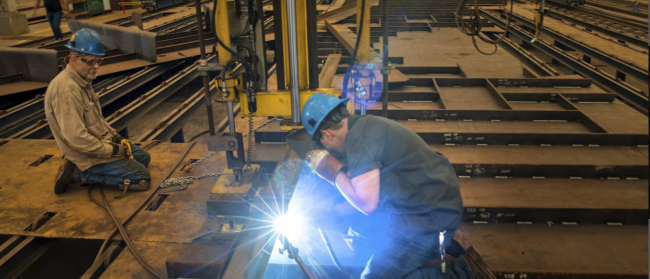Articles Menu

Apr. 29, 2023
Huge changes are coming for our workplaces, quick as a heat wave. This month Joe Biden inked new rules to make all-electrics the majority of new cars sold in America within a decade.
To charge all those batteries, many of the largest states are pushing to power their grids with two-thirds clean energy by the same deadline.
These green shifts have put billion-dollar signs in the eyes of bosses. Public cash is pouring out to subsidize cleaner manufacturing and energy. Corporations aim to cash in double by cutting unions out.
Automakers like General Motors are setting up huge parts of the electric car supply chain in anti-union “joint venture” plants. Solar energy jobs, as of 2022, were 90 percent non-union across the country. Union-busting is even more disgusting in a green disguise.
But as the song goes, “Without our brains and muscle, not a single wheel can turn.” That goes for electric wheels, too.
The enormous sweat and smarts needed for any climate transition worth the name give workers huge potential leverage, from electricians in Arizona to auto workers in Tennessee.
And around these green boom-towns, childcare, education, health, and logistics workers could see their leverage grow, too.
Vast offshore wind farms, solar fields, and new factories are coming soon to hundreds of far-flung places, on tight schedules. That means the few workers available nearby may be able to grab the upper hand.
The massive build-out is a chance to organize for climate transitions on our terms. These fights will set the terms for future workers in the industries we get off the ground.
From its earliest days, Labor Notes has shown how, when the boss plans big changes, workers can stay two steps ahead.
In the 1980s, auto worker Mike Parker saw assembly-line robots coming to steal jobs. He argued that workers should lay claim to programming and repair work before the robots arrived, and make sure the work would be done—or shut down—on union terms.
New reform leaders in the United Auto Workers, the largest manufacturing union in the country, are organizing for a national strike this fall—in part to unionize electric car-making, batteries and all.
Beyond the workplace, one new UAW director immediately moved his region to back the New York Build Public Renewables Act. This bill would have solar and wind power built by the state, publicly owned, and union-made.
But while legislative fights are the only way many unions are tackling climate (and plenty aren’t even doing that), the UAW reformers and their Unite All Workers for Democracy caucus are clear that their strongest leverage is on the job, not in the state house.
As new UAW President Shawn Fain put it, “The founders of this union didn’t wait for the law. They didn’t worry about the law. They wanted their dignity and they wanted their fair share, and they did what the hell they had to do to get it.”
[Top photo: Workers construct a 260-foot-long ship in Terrebonne Parish, La., April 3, 2023. The ship will serve offshore wind technicians and a warehouse for their tools as they operate and maintain wind farms. Ted Jackson/AP.]